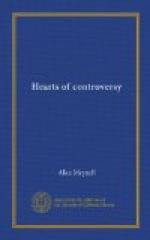We are told of the delight of the Japanese man in a chance finding of something strange-shaped, an asymmetry that has an accidental felicity, an interest. If he finds such a grace or disproportion—whatever the interest may be—in a stone or a twig that has caught his ambiguous eye at the roadside, he carries it to his home to place it in its irregularly happy place. Dickens seems to have had a like joy in things misshapen or strangely shapen, uncommon or grotesque. He saddled even his heroes—those heroes are, perhaps, his worst work, young men at once conventional and improbable—with whimsically ugly names; while his invented names are whimsically perfect: that of Vholes for the predatory silent man in black, and that of Tope for the cathedral verger. A suggestion of dark and vague flight in Vholes; something of old floors, something respectably furtive and musty, in Tope. In Dickens, the love of lurking, unusual things, human and inanimate—he wrote of his discoveries delightedly in his letters—was hypertrophied; and it has its part in the simplest and the most fantastic of his humours, especially those that are due to his child-like eyesight; let us read, for example, of the rooks that seemed to attend upon Dr. Strong (late of Canterbury) in his Highgate garden, “as if they had been written to about him by the Canterbury rooks and were observing him closely in consequence”; and of Master Micawber, who had a remarkable head voice—“On looking at Master Micawber again I saw that he had




